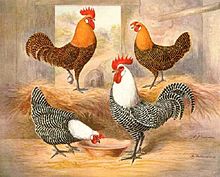Inheritance of color and markings in the domestic fowl
The inheritance of color and markings in domestic fowls is based on several different genes which control the effect of melanin in the plumage . It is important for both economic and hobby chicken breeding.
Plumage color and drawing
Origin of the colors
The ancestor of the domestic chicken , the bankiva chicken ( Gallus gallus gallus ), has very little variety in plumage colors. In modern chickens, however, one can find an immensely large spectrum of colors and plumage patterns that have arisen over the millennia through the selection of mutations.
The biochemical basis of pigmentation
The color of the feathers is determined by the presence or absence of two pigments: eumelanin and pheomelanin . Eumelanin causes a black or deep dark brown color. Pheomelanin leads to a gold color, which can vary between light yellow and dark red. The absence of any pigment results in white plumage.
Gender differences
Except for monochromatic colors and breeds with hen feathering, the color drawing of the hens and roosters of a breed is clearly different. Roosters often have decorative plumage rich in color, that is, long plumage in the neck and back area and long tail feathers.
Wild type
The color variants that correspond to the colors of the Bankiva chicken are usually referred to as "partridge colors" or "wild type". The alleles of the Bankiva chicken are taken as the basis for the genetics of the domestic chicken. The "alleles of origin" are often marked with a plus sign (+).
Importance for chicken farming
Scientific activities related to domestic chicken genetics are often driven by the economic interests of industrial chicken breeding and are often limited to economically relevant aspects such as the white color of broilers. However, hobby chicken breeding has also clarified many genetic phenomena due to the often complicated breeding goals in this area.
Color relevant genes
The genome of the domestic chicken has been completely deciphered for several years. In addition, the chromosomal position of the color-relevant genes was largely clarified (see chromosome map). The following genes are marked with the abbreviations of the English descriptions.
E ("Extended black")
Determines the extent of black in the drawing. There are several alleles: E (uniformly black), E r (Berken), E wh (wheat), e (Columbia) and e + (wild type).
Co ("Columbia")
Determines the extent of the black of the breast and wing plumage in the rooster. Inherited as an autosomal dominant trait .
Db ("Dark brown")
Determines the extent of the black of the breast and wing plumage in the rooster, similar to Co. Inherited as an autosomal dominant trait.
Pg ("Pattern gene")
Controls the fringing of feathers in hens. In roosters, fringing occurs only in combination with other genes. Inherited as an autosomal dominant trait.
Ml ("Melanotic")
Sets the black in the drawing to music. Also determines more complex patterns in combination with other genes. Inherited as an autosomal dominant trait.
Cha ("Charcoal")
Sets the black in the drawing to music, be it less than Ml. Also determines more complex patterns in combination with other genes. Inherited incompletely as an autosomal recessive trait.
Mh ("Mahogany")
Changes gold-colored areas to red-brown. Inherited as an autosomal dominant trait.
Di ("Dilution")
Lightens the gold color. Inherited as an autosomal dominant trait.
Ig ("Inhibitor of gold")
Changes gold color to lemon yellow. Inherited as an autosomal recessive trait.
Cb ("Champagne blonde")
Lightens the gold color, like Di. Inherited as an autosomal dominant trait.
S ("Silver")
Changes the gold color to white. Inherited dominantly gender-linked.
B ("Barred")
Causes the feathers to have horizontal stripes with light and dark stripes. Inherited dominantly gender-linked.
Choc ("Chocolate")
Lightens the black area to brown. Inherited recessive gender-linked.
I ("inhibitor")
Determines the white coloring of the originally black areas, similar to C. Inherited as an autosomal dominant trait. There are also other alleles: I d (brown or beige colored black areas) and I s (gray blue colored black areas).
Bl ("Blue")
Changes black to gray in mixed breed animals. Causes a splash pattern in homozygosity. Inherited incompletely autosomal dominant.
Mo ("Mottled")
Causes white feather tips. Inherited as an autosomal recessive trait.
C ("Colored")
Chromogen, color formation factor, formation of pigment. Inherited as an autosomal dominant trait.
Lav ("Lavender")
Thins black to a light gray and thins gold to Isabel. Inherited as an autosomal recessive trait.
Individual evidence
- ↑ Introduction to the genetics of chicken colors at www.kippenjungle.nl (Dutch) , accessed on May 24, 2016
- ↑ Armin Six en Bettina Müller: Inheritance in chickens and water fowl, Oertel + Spörer, Reutlingen 2007, p. 94.
- ↑ List of the most important domestic chicken genes and their chromosomal position , accessed on May 26, 2016
- ↑ List of color-relevant genes at www.kippenjungle.nl , accessed on May 24, 2016



